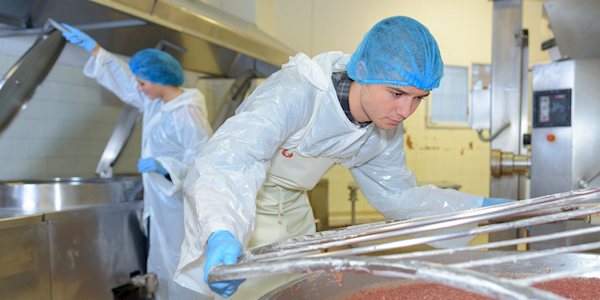
In practical terms machine guarding is a basic safety control for equipment, machines and conveyors in food manufacturing settings. Legally if the protective guarding on a machine capable of causing injury is inadequate the liability lies with the business — and no one wants their workers harmed by machinery or equipment.
Engineering controls such as guards and administrative controls like instruction, training and supervision can help reduce the risks for workers involved in food production.
What are the regulations that apply to guarding food machinery?
There are two sets of regulatory requirements relating to plant and equipment capable of causing injury: the Occupational Health and Safety Regulations 2017 and Australian Standards 4024.1-2014 Series — Safety of Machinery which provides guidelines for machinery guarding.
The regulations that apply in food production settings state that if a business is using guarding, the business has a responsibility to ensure it prevents access to danger points on the equipment or hazardous areas of the plant.
Further, guarding should be a permanent fixture, provided it doesn't prevent necessary access to operating or cleaning the machine. If access is required, the guarding should incorporate an interlocked physical barrier. Interlocking prevents the machine from operating unless it is properly engaged.
If this isn't achievable then the guarding should require the use of tools to be removed or altered, and if that's not practical a presence-sensing monitor should be installed.
How to identify hazards requiring machine guarding
The critical first step in preventing serious injuries from machine injury risks is to analyse how a worker conducts a task involving a machine and what hazards they are exposed to during the process — with a focus on evaluating the relationship between the employee, the task and the equipment.
A comprehensive evaluation of work activities for potential contact with hazardous sources must include the entire machine operation production process, modes of operation, individual activities associated with the operation, and servicing and maintenance of the machine.
Machine guarding risk evaluation requires comprehensive assessment that involves the following key areas where hazards occur.
- Identify all of the activities and steps in the production process, including cleaning and maintenance that require interaction with hazardous machinery.
- Pinpoint hazardous points of machine operations such as cutting, shaping, grinding, or forming of stock.
- Identify power transmission aspects: all the mechanical components that transmit energy to the machine performing the work such as flywheels, belts, chains and gears.
- Evaluate other moving parts of the machine that are in motion while the machine is working such as reciprocating and rotating parts, and feeding mechanisms.
Use this information to ascertain where and when guards are needed. Keep records of this risk management information as proof of your business's safety protocols.
Do protective guards block hazards effectively?
Scrutinising and testing installed guards are important for ascertaining they actually work. If the guards interfere with the process the worker may be tempted to remove them.
Effective machine guarding provide protection from injury by:
- preventing contact — the guard must prevent any part of a worker's body or clothing from making contact with dangerous moving parts at any point
- secure attachment — all machine guards must be securely attached to the machine to prevent tampering or removal
- protecting against falling objects — ensuring that no objects can fall into moving parts and become dangerous projectiles.
Bright, contrasting colours painted on machine guards and points of operation give workers a visual warning, and can make it easy to spot missing guards. Good lighting also helps workers spot dangerous conditions or unguarded machinery.
The importance of operational protocols and employee education
To prevent employee injuries from machines, employees must be able to recognise and understand the hazards of mechanical components. Employees knowing how a safeguard protects them is just as important as having the machine guard itself in place.
Having a mandatory checking protocol helps ensure the protective guards are in place before machinery is operated. Similarly there should be a double locking process for powering off machinery to prevent accidental operation if machine guards are impeded or not in place.
Food manufacturers should have established safe work practices around machinery and other electrical equipment. For operational protocols to be effective workers need to recognise and understand safety around machinery through education and training regarding:
- the location of machine guards and points of operation
- how machine guards provide protection from which hazards
- when and by whom machine guards can be removed
- what to do if a machine guard is missing or damaged
- safety procedures for machines that have been shut down for maintenance or to clear jams
- the importance of regular maintenance to prevent equipment malfunctions.
The surest way to safeguard workers is for everyone to stay alert when working around machinery or moving equipment, and to follow established company safety practices.
How Gallagher can help
Gallagher has a food production specialty team that creates solutions for all the risks that come with producing and distributing food. Our team of industry specialists accesses the Gallagher legacy of 75+ years in servicing food production enterprises, which provides a deep understanding of the risks associated with the industry and how to manage and mitigate them.
We work to explore all the insurance options available to your business, discuss a range of pricing and funding options and ensure that you are appropriately protected against all insurable risks.

